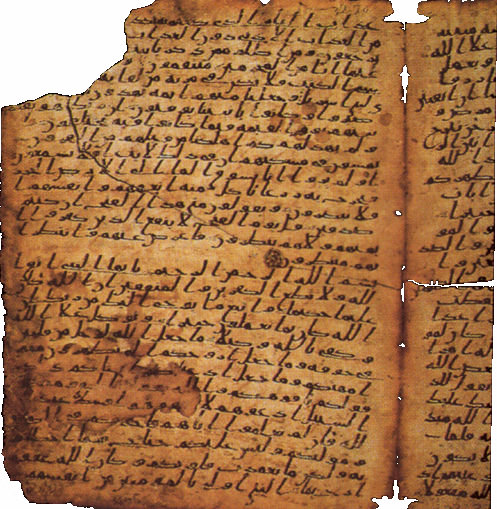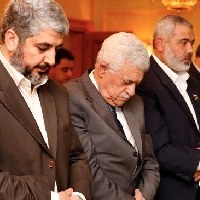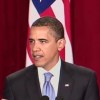![]()
Saturday, July 25, 2015 | By R. Joseph Hoffmann
It is one of the cardinal tenets of Islam that the Qur’an was essentially “complete” in the Prophet’s lifetime and written down very soon after in the time of Uthman before the end of the seventh century. It is a further tenet that the exact wording of the text has remained unchanged from the time of its revelation until today. A standard web-based information site offers the following standard orthodox appraisal:
“The Qur’an is a record of the exact words revealed by God through the Angel Gabriel to the Prophet Muhammad. It was memorized by Muhammad and then dictated to his Companions, and written down by scribes, who cross-checked it during his lifetime. Not one word of its 114 chapters, Suras, has been changed over the centuries, so that the Qur’an is in every detail the unique and miraculous text which was revealed to Muhammad fourteen centuries ago.” (www.islamicity.com, search for ‘What is the Qur`an?’; accessed 25 July 2015)
To this surgically clean declaration of authenticity, one might want to compare the tortured history of the New Testament: academic study has shown that nothing was written by Jesus; nothing was written in Aramaic, the language he spoke, and the written record shows a long history of textual transmission and change going back to a fluid period of “orality” in which specific sayings and deeds were recorded (and others chopped or forgotten). Modern biblical criticism, though it did not begin as this, has been for the last two centuries a systematic exploration of redactions, alterations, variations and theological finessing of texts: There are no original manuscripts and there is today no possibility of finding one that could be indubitably be called “original.” None existed in the time of Jesus or his followers, as far as we know, and it is really not until the end of the first century that written gospels begin to appear — and not until the second that we begin to see hard — papyrological — as opposed to narrative allusions to their existence.
The belief that the Qur’an had an entirely different history from the biblical text was called into question by a palimpsest (a manuscript from which an existing text has been scraped or washed to make room for another one, to avoid the expense of additional writing material) known as ‘DAM 0 1-27.1.’[1], discovered by Muslims in 1972 at the ancient Great Mosque of Sana’a in Yemen.
Aided by ultraviolet photography, this palimpsest was shown to contain many differences compared with today’s Arabic Qur’an. They range from different and missing words and dissimilar spellings to a changed order of Surahs and words within verses. The find is part of a bundle of parchments thought — until a few days ago — to be the oldest surviving copies of the Qur’an. According to Gerd Puin, a western expert in the early text of the Qur’an, the palimpsest known as ‘DAM 0 1-27.1’ contains at least 38 Qur’an leaves. It is undoubtedly extracted from a “book” rather than notes used by imams for the purpose of recalling stories learned by rote. They were each written on parchment with an approximate size of 36.5 x 28.5 cm. Since on the majority of the leaves a primary text is visible and both texts contain parts of over 70 % of today’s Qur’an, the palimpsest must be a remnant of two, previously complete, yet different Qur’ans. ‘Folio 16r’ contains Surah 9:70-80 in the less visible primary writing and Surah 30:26-40 in the better visible secondary writing. The numbers on the right side of the image (annex below) written in cursive type refer to the lines of the earlier, primary text. The normal ones identify the lines in the later, secondary text. The Yemeni Qur’an provides almost conclusive evidence that the text the Qur’an was not settled in the seventh century and underwent the same kind of editorial emendation that parchment-manuscripts routinely went through in the process of copying and transcription.
The Yemen Qur’an’s story is repeated in the work of the Coranica Project. Scholars at the University of Tübingen, examined a Quranic manuscript written in Kufic script, one of the oldest forms of Arabic writing. Using carbon-14 dating on three samples of the manuscript parchment, the researchers concluded that it was more than 95 percent likely to have originated in the period 649-675 AD. The Tubingen Qur’an also showed clear signs of alteration, increasing the probability that the Qur’anic text was altered over time.
The Birmingham “Qur’an”
The discovery in Birmingham University touted by the BBC and happily embraced by Muslim scholars and others as “the oldest” copy of the Qur’an yet discovered is riddled as Robert Spencer argues with journalistic error. The BBC story, trumpeted by news agencies all over the world, is one of those examples of media reporting about religion based on wishful thinking and an ill-disguised hankering for stories about miracles that occasionally remind us that journalism is not science, nor history, or even responsible analysis. Eventually, experts will chime in with questions, the most poignant of which will be these:
- Islamic tradition itself asserts that the Qur’an was finalized during the reign of the caliph Uthman in 653 who ordered “other versions” burned. What were these “other versions” if not variant texts that differed from the text of the one he authorized to be used in his region? Inscriptions at The Dome of the Rock (ca. 691) do not respect the Qur’anic ordering of the surahs as they have come to exist in modern editions of the Qur’an; it would be anomalous indeed if a text (arguably) dating from so close to the Prophet’s lifetime followed the ordering of surahs (chapters) used in later versions of the text.
- The earliest literary reference to the Qur’an as a complete book from the early eighth century, in the context of a debate between a Christian monk from the monastery of Beth Hale (Iraq?) and an Arab nobleman. The dialogue suggests that Muhammad taught a portion of what Muslims believed in the Qur’an and a portion in free floating “surat albaqrah and in gygy and in twrh.” The surah the monk mentions is now fully incorporated in the Qur’an, but in his time was not, since he knows it as a stand- alone book, سورة البقرة, al-Baqara. It is the second and longest surah in the Qur’an as we possess it today.
- The Birmingham University professor, David Thomas, who has made extravagant claims for this discovery does not seem to be aware that he is arguing against his own position: Since (as for a gospel) there is no standard prototype of the Qur’an which could possibly show whether the “original” text has been altered or modified, how can we possibly be sure that the thin series of verses available correspond to an original word order? The Yemen and Tubingen Qur’anic extracts showed just the opposite: under ultraviolet examination they revealed editorial modification or “bleeding” beneath the superscribed text. As Robert Spencer correctly asks, if the only reliable date we have is for the organic material (sheep or goatskin) we still need to date the ink, as Hijazi script, while early, is common in parchment found from this part of the Arabian peninsula.
- The nature of the leaves themselves is puzzling: bits of Suras 18 and 20, “containing a story about Moses (18), along with material about Dhul Qarnayn, who is usually assumed to be Alexander the Great, and the Christian story of the Seven Sleepers of Ephesus, and sura 19, with an extended retelling of the Virgin Birth of Jesus Christ.” These are some of the most obviously derivative sections of the entire Qur’an — stories which the Qur’an cannibalizes without attribution, increasing the likelihood that what we may have is not the Qur’an at all but fragments of stories that were eventually incorporated into the Qur’an at a later period.
Compositionally this may be an exciting archaeological find — since it would tell us something about the real process under which the book was compiled using fragments of other books. Instead, using the traditional religious view of compositional integrity, a theological doctrine rather than a scientific conclusion, the Birmingham experts and the media rush to conclude that we have a kind of proof for the immutability of the text. The Birmingham team as much as admit this since we are told that “the verses are incomplete, and believed to have been an aide memoire for an imam who already knew the Qur’an by heart, but the text is very close to the accepted authorized version.”
- Even if we would allow that the parchment, the ink and the verses coincide to give us the oldest example of Qur’anic material yet discovered, which is not only not conclusive but highly improbable, the question remains why such an early “edition” of the Qur’an should have been circulating among the illiterate Arab populations of the Middle East at such an early date. No one can have read it. It was not used for distribution to masses of believers or potential converts. The only plausible explanation is that what has been found in Birmingham is an aide memoire of a few verses that may correspond to late stories incorporated in the Qur’anic corpus. It is not from that corpus and probably, given the selection of material, was used to preach to Christians and Arabic speaking Jews who were interested in hearing how their own traditions could be reconciled with the teaching of Muhammad. In other words, what has been discovered is proof of the fluidity rather than the rigidity of the Qur’anic compositional process in the late seventh or more likely eighth century.
- Faith before reason: A disturbing feature of this story is in the backlight. The problem is clear enough from this part of the BBC report:
‘The British Library’s expert on such manuscripts, Dr Muhammad Isa Waley, said this “exciting discovery” would make Muslims “rejoice”. The manuscript had been kept with a collection of other Middle Eastern books and documents, without being identified as one of the oldest fragments of the Koran in the world. When a PhD researcher, Alba Fedeli, looked more closely at these pages it was decided to carry out a radiocarbon dating test and the results were “startling”. The university’s director of special collections, Susan Worrall, said researchers had not expected “in our wildest dreams” that it would be so old. “Finding out we had one of the oldest fragments of the Koran in the whole world has been fantastically exciting.” The fragments of the Koran are still legible.’
It is disheartening enough to think that an archivist thinks that archaeology has the reinforcement of religious belief as one of its byproducts, but it is clear from the way the story has been told and disseminated that enthusiasm for an outcome has outdistanced any sober examination of claims. The find is already being touted throughout the Islamic world as a vindication of Islamic belief.
So to repeat: What we have at Birmingham is the discovery of leaves of parchment, probably recycled and scraped and used by a religious teacher to record bits of memorized narrative from sources that finally make their way into the Qur’an. That there should be some overlap in these extracts and later editions of the Qur’an as copied and printed is not at all surprising. But as there is no prototype, it can hardly be said to be evidence of an unalterable textual tradition. There is no compelling reason to think that this slim discovery proves the inviolability of the Islamic holy book, or vindicates any doctrine. In fact, if treated intelligently and using the methods of western textual criticism, this could shed light on how books like the Qur’an evolved over time to become compendiums of the words of men regarded as the prophets and teachers of their tradition. So far however, we see little evidence that the find will be treated in that way. As Gerd Puin has said,
“My idea is that the Koran is a kind of cocktail of texts that were not all understood even at the time of Muhammad. Many of them may even be a hundred years older than Islam itself. Even within the Islamic traditions there is a huge body of contradictory information, including a significant Christian substrate; one can derive a whole Islamic anti-history from them if one wants…”
What we have at Birmingham perfectly illustrates that point.
ANNEX: The Textual Variants in the Yemini Qur’an described by Professor Gerd Puin:[2]
A. Several words are missing within a paragraph leading to a different meaning:
Sahih International translation: ‘… (if) they turn away, Allah will punish them with a painful punishment in this world and the Hereafter. And there will not be for them on earth (any protector or helper.)
Sana’a manuscript, ‘DAM 0 1-27.1’, translation: ‘… (if) they turn away, Allah will punish them in this world. And there will not be for them on earth (any protector or helper.)
The finishing letter, ‘Alif’, in ‘yatawallaw’, ‘they turn away’, found in today’s standard text of the Quran is missing in the early manuscript under discussion, as indicated by the empty box with a black frame above. Moreover, in the the verb ‘yu’addibhum’, ‘he (Allah) will punish them’, found on ‘Fol. 16r, Z.13’, is not explained with ‘adaban aliman’, ‘with a painful punishment’, as in the Standard Text (StT). There one finds ‘fi‘l-dunya wa-‘l-ahirati’, ‘in this world and in the Hereafter.’ The Sana’a manuscript contains only ‘in this world’ and therefore fits better with the end of the verse in both versions: ‘And there will not be for them on earth any protector or helper.’
B. Words are different from today’s Quran:
The shaded area above indicates uncertainty. Instead of the word ‘gahannnamu,’ ‘hell’, found in the Standard Text, the old manuscript version contains the synonym ‘l-naru’, ‘the fire’, found in the box with the interrupted frame. It is almost identical with a parallel text found in today’s Surah 24:57: ![]()
The word ‘yaqsimuna’ in the old manuscript, found in the box with the interrupted frame above, has been replaced by the different, yet synonymous, ‘yahlifuna’, ‘they swear,’ in today’s Quran. The words that follow, crossed with horizontal lines, have been reconstructed with certainty. Behind the ‘Kaf’ of ‘kalimat’, ‘(the) word’, a part of the manuscript is missing. The grey, shaded area indicates uncertainty about the original word. The room left on the parchment allows only for ‘(ka)limata ‘l kufri’, ‘(the) word (of) the disbelief’. The next line in the manuscript starts with ‘wahammu bima lam yanalu’. Therefore, the phrase ‘wakafaru baʿda is’lāmihim’, ‘and disbelieved after their (pretense of) Islam’,[3] is only found in the today’s Standard Text. The three words missing in the text form used by the old manuscript are again indicated by the white box with the black frame.
Whereas the secondary text of the examined palimpsest comes close to the content of today’s Quran, it is still not 100% identical. None of the numerous changes under discussion are mentioned in the Qirâ’ât literature that is concerned mostly with methods of pronunciation used in the recitations of the Qur’an. The changes are also different from those found in the collections of the Quran by Ibn Mas’ud, known primarily for the absence of Surah 1, 113 and 114, and Ubay bin Ka’b who listed two additional Surahs.[4]
R. Joseph Hoffmann graduated from Harvard Divinity School and the University of Oxford (Ancient Near Eastern Studies). Hoffmann was tutor in Greek at Keble College and Senior Scholar at St Cross College, Oxford, and Wissenschaftlicher Assistent in Patristics and Classical Studies at the University of Heidelberg. He taught at universities in the United States, Britain and Lebanon. He has held visiting positions at universities in Africa, the Middle East, the Pacific and South Asia. He is now Professor of Liberal Arts at the American University of Central Asia. Beyond academe, he is well known for his advocacy of the humanist tradition. In his recent work, Hoffmann has turned increasingly to the work of ”humanist restoration”. His most recent books include an edited volume entitled Just War and Jihad: Violence in Judaism, Christianity and Islam (2006) and Sources of the Jesus Tradition (2010.) His study of the concept of the right to life in early Christianity, Faith and Foeticide, will be published in 2015, along with another in his series of translations of the classical philosophical critiques of the Christian movement: Christianity: The Minor Critics. He blogs at The New Oxonian. Read his full biography here. For all the exclusive blog entries by R. Joseph Hoffmann, go here.
![]()
Notes:
[1] Codex Ṣanʿāʾ DAM 01-27.1 — A Qur’ānic Manuscript From Mid-1st Century Of Hijra, accessed 25th July 2015.
[2] answering-islam.org, accessed 25th July 2015.
[3] Translation and transliteration of this phrase are taken from the Quran Corpus site, accessed 25th July 2015.
[4] ‘Itqan I’ by Suyuti, p.62, 65, Bukhari, 6, No.521, Fihrist, I, pages 53-57, ‘Masahif’ by Ibn Abi Dawud, pp.180-181.



 RSS
RSS














Latest Comments
Hello Mike, Thank you for your positive feedback to the article. I felt there wasn’t too much critical analysis of ...
Thanks for this considered and well constructed article. A follow up article on the manner in which the editorial contro...
THE CLUELESSNESS OF CLAIMING THAT OBAMA'S MIDDLE EAST POLICIES WERE A FAILURE CANNOT BE FURTHER FROM THE TRUTH, WHAT THE...
As long as Obama is the president of the usa do not trust the us government......
Thank you for an good read....